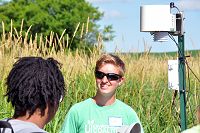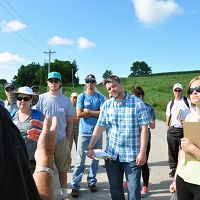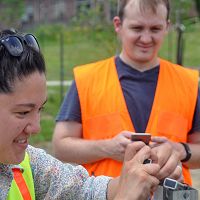Clear Creek Watershed Research & Conservation Efforts: Katie Goff
07 Jul 2016
Katie Goff is a masters student studying earth and environmental sciences at the University of Iowa. As part of her research, Goff collects data and water samples from various rural and urban sites in Iowa and Johnson Counties. This project falls within the Clear Creek Watershed, which is one of thee watersheds studied in the Intensively Managed Landscapes-Critical Zone Observatory.
Goff recently sat down with us to discuss her research and her work in the Clear Creek Watershed.
You studied geoscience and anthropology as an undergraduate at the University of Iowa and now you're working on your master's in earth and environmental sciences. What attracted you to this particular field?
I am attracted to Earth Science writ large because of the infinite mystery of our environment. We as a species live on this planet and our ever curious minds want to learn more about our Earth and there is always more to know. I’m interested in understanding our environment as a function of reducing the human impact on the Earth and prolonging the sustainability of resources for all biota. I believe we have a responsibility to our planet to learn as much as we can and act wisely in response to that knowledge.
You're working with IML-CZO Investigator Dr. Art Bettis on a project. Tell me a bit about this project, your role in it, and your findings thus far.
The IML-CZO endeavor stands for Intensively Managed Landscapes Critical Zone Observatory. It is a National Science Foundation funded project that hosts sites all around the nation to help better understand the unique biomes of each place in the country. The Midwest is known as the heartland and the breadbasket of America with agricultural activities occupying more than 90% of the state of Iowa – this is intensive management. The overarching goal of the IML-CZO is to understand the impact that human activity may be having on the critical zone – the biota, the soil, the water, the atmosphere, and the overall landscape. It is imperative that we understand first the environment we live in and how it may be changing due to our actions or other unforeseen factors. My role in the IML-CZO is looking primarily at the Quaternary sedimentary package that the modern soil has been developed in. I’m concerned with what we call the “weathering zone” or how the soil profile develops over time and how it is chemically altered as you move down through the profile. Water plays a very important role in the weathering zone – it is the primary force that transports solutes through a soil profile and keeps the “weathering machine” going. My overall goal is to learn more about the chemical alterations that take place during the weathering of these sediments and how water moving through the profile interacts and alters them.
The Clear Creek Watershed encompasses both rural and urban areas of Eastern Iowa. Of course you're with a public sector entity at the University of Iowa but you've worked closely with farmers, landowners, and others from the private sector. Why do you think collaboration between the public and private sectors are important for projects such as these?
Collaboration between “rural” and “urban” entities is of the utmost importance and especially in the state of Iowa. We are all in this together – whatever we do in the urban setting will eventually effect people in a rural setting and vice versa. Our impacts are not limited to the space that we may occupy or own and all of us need to take responsibility for the actions we take that may impact others. Having a better understanding of our environment through endeavors like the IML-CZO will help us meet the need of those particular collaborations. The collaboration between public and private sector is also very key. We can learn from one another and make strides in the fields we are in that would not be possible without collaboration. I think that is one thing in particular that I like about the CZO framework is that collaboration between different disciplines is absolutely necessary if you want to be able to understand these complex systems we are studying – everything is connected to one another.
What are your plans for when you graduate?
When I graduate in May 2017, I hope to find a job in the public or private sector where I can continue to explore my love of the environment and continue to serve the public as a steward of our environment.
Anything else you want to add that I haven't addressed?
I’ve very much enjoyed working with the IML-CZO and learning about all the different things people are doing – there is so much more to be discovered out there.
By Nick Fetty (Center for Global and Regional Environmental Research, University of Iowa)
Photos
Clear Creek Watershed Research & Conservation Efforts: Katie Goff

Katie Goff (Master's Student, Earth and Environmental Sciences), right, listens to a presenation by Dr. Art Bettis (Clear Creek Site Coordinator) during the Critical Zone Observatory Environmental Sciecne Workshop on June 28, 2016. Photo: Nick Fetty (Center for Global and Regional Environmental Research, University of Iowa)

Katie Goff (Master's Student, Earth and Environmental Sciences) discusses water quality and other measurements regularly taken at a research site in Iowa County during the Critical Zone Observatory Environmental Sciecne Workshop on June 28, 2016. Photo: Nick Fetty (Center for Global and Regional Environmental Research, University of Iowa)

Katie Goff (Master's Student, Earth and Environmental Sciences) reassembles a gauage that measures water quality and other metrics during the Critical Zone Observatory Environmental Sciecne Workshop on June 28, 2016. Photo: Nick Fetty (Center for Global and Regional Environmental Research, University of Iowa)

Katie Goff (Master's Student, Earth and Environmental Sciences) reassembles a gauage that measures water quality and other metrics during the Critical Zone Observatory Environmental Sciecne Workshop on June 28, 2016. Photo: Nick Fetty (Center for Global and Regional Environmental Research, University of Iowa)

Katie Goff (Master's Student, Earth and Environmental Sciences) works with Sarah Parcher (Undergraduate, University of Nebraska-Omaha) during the Critical Zone Observatory Environmental Sciecne Workshop on June 28, 2016. Photo: Nick Fetty (Center for Global and Regional Environmental Research, University of Iowa)

Katie Goff (Master's Student, Earth and Environmental Sciences) explains how to measure water quality to Monique Cottman (Teacher, Iowa City Longfellow Elementary) during the Critical Zone Observatory Environmental Sciecne Workshop on June 28, 2016. Photo: Nick Fetty (Center for Global and Regional Environmental Research, University of Iowa)

Katie Goff (Master's Student, Earth and Environmental Sciences) reads a gauage that measures water quality and other metrics during the Critical Zone Observatory Environmental Sciecne Workshop on June 28, 2016. Photo: Nick Fetty (Center for Global and Regional Environmental Research, University of Iowa)

Katie Goff (Master's Student, Earth and Environmental Sciences) works with Sarah Parcher (Undergraduate, University of Nebraska-Omaha) during the Critical Zone Observatory Environmental Sciecne Workshop on June 28, 2016. Photo: Nick Fetty (Center for Global and Regional Environmental Research, University of Iowa)

Katie Goff (Master's Student, Earth and Environmental Sciences), right, works with Dr. Art Bettis (Clear Creek Site Coordinator) to take a measurement of the groundwater during the Critical Zone Observatory Environmental Sciecne Workshop on June 28, 2016. Photo: Nick Fetty (Center for Global and Regional Environmental Research, University of Iowa)
As part of her research, Katie Goff (Master's Student, Earth and Environmental Sciences) records measurements and takes water samples to gauge the effectiveness of conservation techniques at a research site in Iowa County.
People Involved
CZO
-
IML, GRAD STUDENT
-
IML, GRAD STUDENT
-
IML, INVESTIGATOR
Related News
Explore Further







